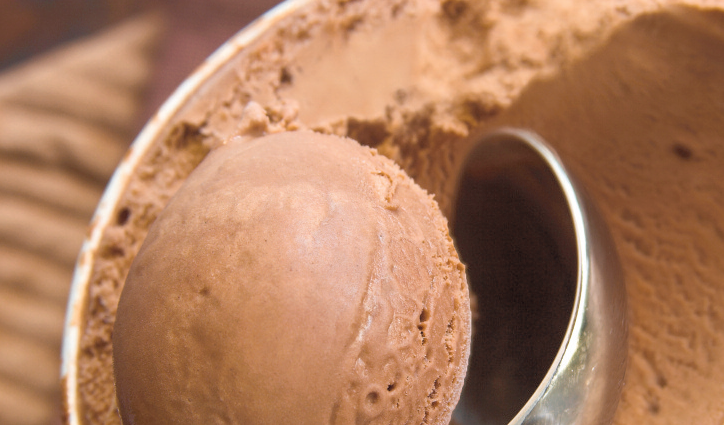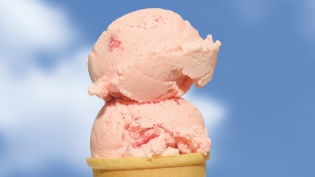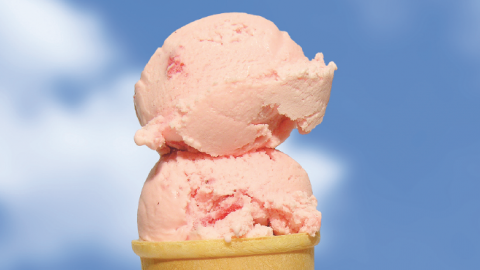Everything You Need to Know About Ice Cream
I know two words that will probably bring a smile to your lips: ice cream. Cold, creamy, sweet ice cream.
Chocolate. Vanilla. Strawberry. Butter pecan. Those are the top four flavors sold in the United States. Or perhaps you would prefer more exotic flavors like boysenberry or salted caramel or even basil or bacon.
Whatever your preference, chances are you've enjoyed some ice cream recently. In fact, the national average for ice cream consumption is 48 pints per year, more than any other country. Although I was unable to find any statistics to support it, I think it's safe to assume that we desert dwellers consume at least as much if not more than the national average.
What is ice cream?
Federal law dictates that regular ice cream sold in stores must have at least 10% milk fat, also known as butterfat. Many "premium" ice creams exceed that amount and can go up as high as 16% milk fat.
Milk fat content is one of the determinants of the texture of ice cream. More milk fat usually results in creamier ice cream, although there are other factors that affect creaminess. Jan Wichayanuparp, one half of the team behind Sweet Republic Ice Cream in Scottsdale, warns that too much of a good thing is not a good thing. "If an ice cream is too high in butterfat, the fat will coat the tongue and interfere with your ability to taste the flavor of the ice cream."
I know I'm supposed to be a foodie so you would expect that I would eat mostly premium ice cream but I will admit, without embarrassment, that I'm also a fan of astronaut ice cream (freeze-dried ice cream) and Dippin' Dots (super cold beads of ice cream). Both are considered ice cream by the legal definition since they contain at least 10% milk fat.
It might surprise you to learn that gelato is not technically ice cream because it has a lower milk fat content (usually 3% to 8%). Gelato tastes very creamy, though, and gives the impression that it is high in fat. The creaminess of gelato comes from the way it is churned and the temperature at which it is scooped. Gelato is churned less than ice cream and therefore has less air (called overrun in the industry) in the final product, resulting in a denser texture that makes it feel very creamy on your tongue even though the milk fat content might not be as high as regular or premium ice cream. And it is usually served at a higher temperature than ice cream, also adding to the perception of creaminess.
Less expensive commercially prepared ice creams often do not feel creamy on the tongue. That's because they have had more air pumped into them. They are still 10% or more milk fat but the extra amount of air changes the texture.
How is ice cream made?
Ice cream is made from milk, cream, nonfat dry milk, sugar and flavorings. Eggs are often added to ice cream to increase stability and improve texture. When those ingredients are mixed and heated, they form the base for the ice-cream-making process.
The base is flavored, cooled and then churned. The resulting frozen mixture will be soft. To make it more like conventional ice cream, it is hardened for several hours in the freezer.
In describing the ice-cream-making process, Wichayanuparp stressed how speed and temperature affect the final product. "You want the final product to have uniform ice crystals because smaller uniform crystals give a smoother texture. Freezing the base rapidly will yield smaller crystals."
That's one of the reasons that ice cream made at home often cannot compare to ice cream made by a professional who has equipment that can freeze the ice cream to a lower temperature more quickly.
Homemade? From scratch? Artisan?
So, what's the difference? For the most part, probably the size of the batches that are produced. Remember that to be called ice cream, the frozen dessert has to have a minimum 10% milk fat content. The terms "from scratch," "artisan" and "homemade" are not regulated at this time. But it's probably safe to assume that if someone uses one of those terms to describe her ice cream, the product is probably made in smaller batches than a commercially produced product you might find in the supermarket.
How to store ice cream
Be sure to keep the container covered well. Store ice cream in the freezer as soon as you finish making it or as soon as you get it home from the store. If the ice cream is allowed to melt even a little, the flavor and texture will suffer when it is refrozen in the freezer. Commercially prepared ice cream should not be stored for more than a few weeks, or even less time if your freezer isn't cold enough. Ice cream you make at home has a much shorter shelf life. But that shouldn't be a problem if you've made a good batch!
How to eat ice cream
I know. You don't need any help eating ice cream. So you think. According to Wichayanuparp, for maximum flavor, ice cream should be softened slightly before eating. Not on the countertop. Not in the microwave. But in the refrigerator for just a few minutes until it is scoopable. If the ice cream is allowed to soften too much and then put back in the freezer, ice crystals will form, affecting the quality of the ice cream. So my advice is to eat it all at one sitting.
Of course, a nation that consumes so much of the frozen treat would have a national holiday devoted to the cold creamy delight. So what flavors are you planning to indulge in for National Ice Cream Day, July 16?
MADE RIGHT HERE
Sweet Republic 9160 E. Shea Blvd., Scottsdale
Churn 5223 N. Central Ave., Phoenix
Mary Coyle 5521 N. Seventh Ave., Phoenix
Karen's Kremery (several locations)
Udder Delights 1385 E. Warner Rd. #103, Gilbert






